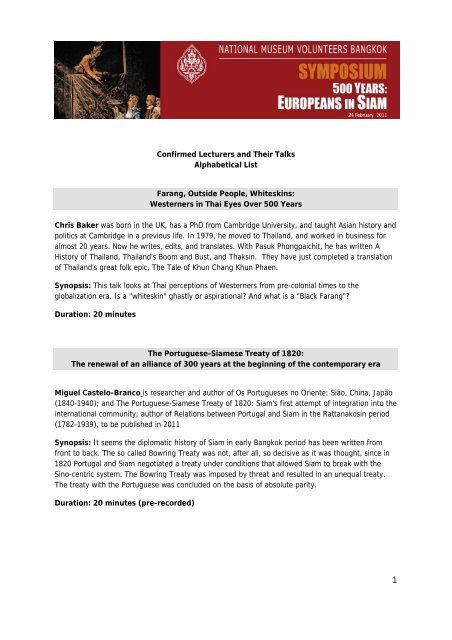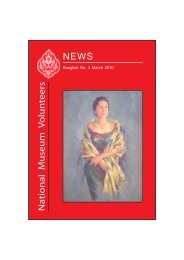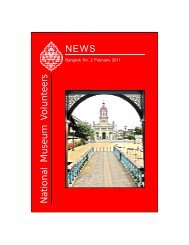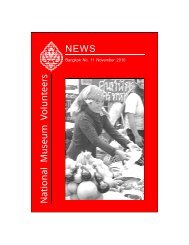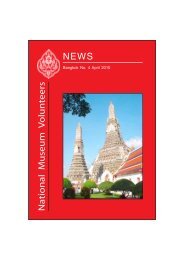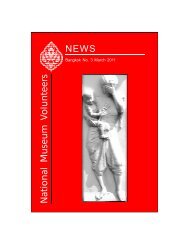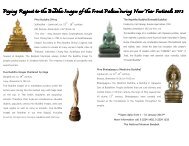details - National Museum Volunteers
details - National Museum Volunteers
details - National Museum Volunteers
You also want an ePaper? Increase the reach of your titles
YUMPU automatically turns print PDFs into web optimized ePapers that Google loves.
Confirmed Lecturers and Their Talks<br />
Alphabetical List<br />
Farang, Outside People, Whiteskins:<br />
Westerners in Thai Eyes Over 500 Years<br />
Chris Baker was born in the UK, has a PhD from Cambridge University, and taught Asian history and<br />
politics at Cambridge in a previous life. In 1979, he moved to Thailand, and worked in business for<br />
almost 20 years. Now he writes, edits, and translates. With Pasuk Phongpaichit, he has written A<br />
History of Thailand, Thailand’s Boom and Bust, and Thaksin. They have just completed a translation<br />
of Thailand’s great folk epic, The Tale of Khun Chang Khun Phaen.<br />
Synopsis: This talk looks at Thai perceptions of Westerners from pre-colonial times to the<br />
globalization era. Is a "whiteskin" ghastly or aspirational? And what is a "Black Farang"?<br />
Duration: 20 minutes<br />
The Portuguese-Siamese Treaty of 1820:<br />
The renewal of an alliance of 300 years at the beginning of the contemporary era<br />
Miguel Castelo-Branco is researcher and author of Os Portugueses no Oriente: Sião, China, Japão<br />
(1840-1940); and The Portuguese-Siamese Treaty of 1820: Siam's first attempt of integration into the<br />
international community; author of Relations between Portugal and Siam in the Rattanakosin period<br />
(1782-1939), to be published in 2011<br />
Synopsis: It seems the diplomatic history of Siam in early Bangkok period has been written from<br />
front to back. The so called Bowring Treaty was not, after all, so decisive as it was thought, since in<br />
1820 Portugal and Siam negotiated a treaty under conditions that allowed Siam to break with the<br />
Sino-centric system. The Bowring Treaty was imposed by threat and resulted in an unequal treaty.<br />
The treaty with the Portuguese was concluded on the basis of absolute parity.<br />
Duration: 20 minutes (pre-recorded)<br />
1
European Education of the Thai Elite<br />
M.R. Chakrarot Chitrabongs is the grandson of Prince Naris and Prince Damrong, half-brothers of<br />
King Chulalongkorn. Sent to the UK when thirteen, he returned at thirty, after undergoing English<br />
public school and university education, and professional architectural training. He is one in the last<br />
generations of Thai elite who had the opportunity to be educated comprehensively in Europe. On his<br />
return, he joined the Government Service as teacher of European Art History, before being<br />
transferred to a variety of duties in officialdom. The zenith of his career was his Royal Appointment as<br />
Secretary General of the <strong>National</strong> Culture Commission and Secretary General of the Ministry of<br />
Culture. After retirement, he has devoted himself to teaching in higher education.<br />
Synopsis: The educational system for the Thai elite – the children of the royalty and the nobility –<br />
underwent drastic transformation during the middle Ratanakosin Period during the reigns of Kings<br />
Rama IV (r.1809-1868) and Rama V (r.1868-1910). Prior to this period, the traditional education had<br />
consisted of tutorship using the Buddhist religious texts for lessons in literacy and knowledge. The<br />
reform was led by King Rama IV, while ordained as a Buddhist monk and before his accession to the<br />
throne, who educated himself with European academy achieving proficiency in English, Latin and<br />
Astronomy. Subsequently, as sovereign king, he arranged for his own children to be educated under<br />
the guidance of European nationals hired for the purpose of educating members of the Royal Court.<br />
When King Chulalongkorn came to the throne as a juvenile king, he proceeded to educate himself by<br />
visiting the neighbouring states that were under European rule to see for himself the advances in<br />
modernisation that European education and culture could bring to Southeast Asia. He then decided to<br />
send all of his male offsprings to the European states to be educated. The royalty were soon followed<br />
by the children of the nobility and a new tradition for a European education for the elites of the Thai<br />
society was born.<br />
This paper presents an account of the state of the elitist education prior to the onset of European<br />
education, the early stages of European education of the royalty and subsequent opportunities for the<br />
upper-classes and scholarship winners. There will be also some information on the successes of the<br />
European educated individuals in their subsequent livelihood in the home country.<br />
Duration: 20 minutes<br />
The Politics of Dressing Up<br />
M.L. Chittawadi Chitrabongs was trained as a Thai architect. Her realized work is a set of<br />
lavatories in Chulalongkorn University. On a scholarship from the Thai Government she received her<br />
MA and PhD in History and Theory of Architecture from the Architectural Association School of<br />
Architecture in the UK. Her entry in the first ‘Thai Fashion Competition’ held by the Thai Embassy in<br />
London won second prize. She presented her paper on Crematoria at the 7 th International Conference<br />
on Death, Dying and Disposal at the University of Bath in 2005 and published her essay on The<br />
Politics of Dressing Up in 2010. She has been teaching on the Faculty of Architecture, Chulalongkorn<br />
University, since 2010.<br />
Synopsis: This presentation is based on research for her PhD thesis which documented a process of<br />
hygiene reforms carried out by King Rama V of Siam (who reigned from 1868 until 1910) and her<br />
Thai ancestors. The work depended on access to the King’s manuscripts from the royal archives<br />
which made it possible for the thesis to construct the following arguments. King Rama V was aiming<br />
to increase the royal authority in Bangkok by imposing his ideas of order and neatness. The fact that<br />
2
these were anti-traditional was precisely why his reforms provoked much opposition. It was not just<br />
that King Rama V wished for the Siamese to be clean and tidy, he wanted to be able to mould his<br />
household and, by extension, the inhabitants of Bangkok. King Rama V had wished to break the<br />
Siamese habits, especially where they manifested themselves as eyesores. In order to do this, he was<br />
willing to import and to use contemporary objects and practices (such as Englishmen’s hats and<br />
western tailoring). But one should not read King Rama V’s reforms as ‘westernization’. Within this<br />
lecture she will suggest the idea that the bowler hat represented a highly developed fantasy<br />
connected to the return of King Rama V as a fatherly ghost.<br />
Duration: 15 minutes<br />
The Russian Connection with Siam:<br />
From Tsar Nicholas II to Vladimir Putin<br />
Ines Ehrlich is a freelance feature writer who has written on Thailand’s art, history and architecture.<br />
Synopsis: A quick review of the unique ties formed between the Tsar of Russia and King<br />
Chulalongkorn that proved instrumental in staving off colonization of Siam and preserving its<br />
sovereignty. In 1897 King Chulalongkorn viewed the situation of territorial losses so potentially<br />
serious that he embarked on a grand European tour hoping to establish "balancing" friendships with<br />
as many European nations as possible. Much of the success achieved during the King’s nine month<br />
journey can be attributed to his friendship with Tsar Nicholas II, a relationship forged during the<br />
Tsarevich's state visit to Siam in 1891, before becoming the Tsar of Russia. The Tsar’s genuine<br />
friendship with the King influenced his European counterparts to accept the Siamese King as a royal<br />
equal. The King’s visit to Russia marked the beginning of diplomatic relations between The Romanov<br />
Dynasty and Siam, which later developed to the point that France and other world powers<br />
relinquished their attempts at Siam’s sovereignty.<br />
Duration: 10 minutes<br />
Constantine Phaulkon – Falcon , Facts and Fiction<br />
Alain Forest , Professeur, Université Paris-Diderot/Paris 7, is author of “Falcon, L’Imposteur de<br />
Siam” and “Cambodge: Histoire et Religion” to be published in 2011.<br />
Synopsis: The life of Phaulkon cannot be covered in ten minutes. But, Prof. Forest will give a brief<br />
overview about reality and legends of this fascinating man that could be taken a role model for a<br />
successful career in Siam and a globalized world.<br />
Duration: 10 minutes (pre-recorded)<br />
The French in Siam<br />
Claire Keefe-Fox was born in Italy, grew up in the United States, France and Italy, and attended<br />
university in England, Italy, Switzerland and France. Working as an interpreter since 1975, she was<br />
official interpreter to the French Government until 2009. Her first book, Le Ministre des Moussons,<br />
about Phaulkon, occasioned her participation in "Bouillon de Culture", the most prestigious cultural<br />
program on French television. She has since written other books that have won recognition, some of<br />
3
which have been translated into Thai and sold well ; and she is currently writing The Tears of Siam.<br />
She is at present Director of Alliance Française for Thailand.<br />
Synopsis: In the 17 th century, according to archival sources, the first French to venture to Siam<br />
were Jesuits and, shortly after, members of the “Missions Etrangères de Paris”, who established<br />
themselves in Ayudhya and recounted the trials and tribulations of dealing with a new, unsettling<br />
culture and a well established religion.<br />
In this age of exploration and first attempts at creating global trade networks, merchants and<br />
diplomats followed, the latter with far from unqualified success as is well known from the thoroughly<br />
documented embassy sent by King Louis XIV to the court of King Narai in 1685.<br />
After the hasty withdrawal of the French mission and troops following the “Revolution of Siam” of<br />
1688, the missionaries were left behind to fend for themselves, until the end of the 19 th century,<br />
when Siam became a pawn in the great power play of colonial empire building and the quest for raw<br />
materials, the French largely ignored the scene of their first attempt—and failure—to establish a<br />
foothold in Asia.<br />
Faced with the “Parti Colonial” becoming ever more powerful in France, and greedy for more Asian<br />
colonies to bolster the Indochinese possessions in the East, along with the encroaching British<br />
Empire on its western and southern borders, Siam was forced into a difficult balancing act between<br />
dangerous neighbors, the need to modernize, and threats to its independence.<br />
But shared danger creates unity, and although the kingdom did not emerge unscathed, it was<br />
nonetheless able to weather the storm and face the challenges of the 20 th century with defined and<br />
recognized borders, and more importantly still, a sense of nationhood.<br />
Duration: 20 minutes<br />
German traces of one of the oldest corporate citizens in Thailand:<br />
B.Grimm’s more than 130 years of doing business with compassion<br />
Harald Link joined B.Grimm in 1978 after receiving an MBA at the University of St. Gallen,<br />
Switzerland. In 1987 he was appointed Chief Executive and is currently serving as Chairman of the B.<br />
Grimm Group.<br />
Synopsis: A German by descent, Harald Link finds himself curiously reflecting a Thai sensibility<br />
filtered through his German upbringing: “I feel Thai but at the same time have strong German roots.”<br />
In his talk, Harald Link explores the unique standpoint of the B.Grimm Group in Thai history.<br />
Established in 1878 as one of the first German firms to be incorporated in Thailand, B.Grimm stands<br />
as a diversified business corporation with roots irrevocably entwined with Thailand and its people.<br />
B.Grimm is very German yet very Thai, something reflected in the company’s very purpose: doing<br />
business with compassion for the development of civilization. Expect a fascinating journey from the<br />
first Western medicine for the Kingdom to pioneering into private power plants and teaching children<br />
about science.<br />
Duration: 20 minutes<br />
The first Europeans in Siam – the Portuguese<br />
Giacomo (Jack) Mauri, President of the Dante Alighieri Association of Bangkok was a former<br />
business executive with Exxon Corporation with postings in the United States, Japan and Thailand.<br />
After retirement, he returned to Bangkok and taught marketing at Thammasart University. He has<br />
reverted back to an old passion for history and culture. Over the past seven years, he has conducted<br />
4
esearch on 16 th century Siamese history in a programme at Chulalongkorn University, relying largely<br />
on a collection of Portuguese documents at Cornell University.<br />
Synopsis: The Portuguese laid siege to Malacca in 1511 under the command of Admiral Afonso<br />
D’Albaquerque and immediately sent an envoy to Ayutthaya to establish relations with Siam – the first<br />
time in history that a European had been received in Siam (Ayutthaya).<br />
In their quest to establish a direct route by sea from the spice producing areas of Southeast Asia and<br />
thereby to bypass complex land and sea routes controlled by Middle Eastern and Venetian merchants,<br />
the Portuguese had managed to navigate around the Southern tip of Africa and get to India just a<br />
few<br />
The spice trade was an extremely lucrative trade that strongly appealed to small, impoverished<br />
Portugal. What did the Portuguese seek in their mission to Ayutthaya? Significantly, Duarte<br />
Fernandez, the first Portuguese envoy, travelled to Ayutthaya aboard a Chinese merchant vessel, not<br />
a Portuguese warship. The Siamese responded favorably, seeking in turn better firearms from the<br />
Portuguese. Various types of Portuguese were involved in 16 th century Siam: conquerors, traders,<br />
mercenaries and missionaries. Jack’s presentation will briefly describe their types and their<br />
successes, or lack thereof.<br />
But were the Portuguese really the first Europeans to reach Siam? Meet two Italians: Nicolo’ De’<br />
Conti and Ludovico De Varthema.<br />
Duration: 20 minutes<br />
Italians at the Court of Siam<br />
Prof. Paolo Piazzardi, is former Cultural Attaché at the Italian Embassy in Bangkok and co-author<br />
of Italians at the Court of Siam<br />
Synopsis: Between the end of the 19th century and the early 20th an outstanding community of<br />
Italian architects, engineers, artists and artisans gave their skills to make Bangkok the modern capital<br />
of the kingdom.<br />
The protagonists of this fascinating story are portrayed in this Symposium, with a stress on their<br />
private lives, as in the book ‘Italians at the Court of Siam’, a human document rather than a treatise<br />
on their artistic styles.<br />
Duration: 20 minutes (pre-recorded)<br />
Living the Dangerous Dutch Life in Ayutthaya<br />
Bhawan Ruangslip obtained her doctoral degree in history at Leiden University and is currently a<br />
lecturer at the History Department, Faculty of Arts, Chulalongkorn University. She is the author of<br />
Dutch East India Company Merchants at the Court of Ayutthaya: Dutch Perceptions of the Thai<br />
Kingdom, c. 1604-1765 (Leiden: Brill, 2007).<br />
Synopsis: The Dutch East India Company (VOC) arrived in Ayutthaya in 1604. Originally considering<br />
the Siamese capital and port city as a stepping stone for reaching China, the Dutch merchants found<br />
potential benefits in Siamese goods, and decided to open a trading post.<br />
5
During their 160 years in Ayutthaya, they were traders, diplomats, courtiers, as well as employers,<br />
parents and community members who needed to understand not only the local pattern of commerce<br />
but also the Kingdom’s political situation, socio-cultural conditions and interpersonal relationships.<br />
Duration: 20 minutes<br />
Are the longstanding Thai-Portuguese relations connected with the popular Thai dessert<br />
Foi Thong?<br />
Bulong Srikanog, of the Division of Literature and History of the Fine Arts Department is a<br />
documentary scriptwriter and lecturer on Thai History and Thai Studies at Silpakorn University and<br />
Chulachomklao Royal Military Academy, and is currently involved in The Research Project of Thai-<br />
Portuguese Relations.<br />
Synopsis: When Portugal is mentioned among Thais, the image that a surprising number of them<br />
come up with is foi thong, or “golden threads”, a Thai dessert made of egg yolks and sugar, having<br />
its roots in Portugal. This reflects the long existence of this dessert in Thai life and culture, since foi<br />
thong is usually found in major traditional events and ceremonies all year round. In a wedding<br />
ceremony, for instance, it is served as a symbol of lasting love and happiness. Using evidence from<br />
old documents, historical records, and significant sites spanning from Lisbon to Ayutthaya, this lecture<br />
will examine many aspects of Thai-Portuguese relationships.<br />
Duration: 20 minutes<br />
Chao Phya Abhai Raja Gustave Rolin-Jaequemyns,<br />
General Adviser of H.M. King Chulalongkorn<br />
Count Gerald van der Straten Ponthoz hails from a Belgian aristocratic family whose members<br />
include many important figures. The ancestry of Phya Abhai Raja Gustave Rolin-Jaequemyn can be<br />
traced back to his grandmother’s family tree. He is the founder and Chairman of the Chao Phya Abhai<br />
Raja Siammanukulkij Foundation.<br />
Synopsis: Meet Gustave Rolin-Jaequemyns, who devoted nearly a decade of his life to the service<br />
of King Chulalongkorn. He loyally served the visionary king as General Adviser between 1892 and<br />
1901. His main responsibilities were to reform the judicial system and develop the administration of<br />
Siam. He worked with the utmost honesty for the progress of Siam and was very trusted by His<br />
Majesty who invested him with the title of Chao Phya Abhai Raja Siammanukulkij, which was the<br />
highest title that a foreigner had ever received.<br />
Duration: 10 minutes<br />
Putting the Golden Land on the Map<br />
Thavatchai Tangsirivanich, Thailand's leading map connoisseur and author of Ayutthaya in<br />
European Maps, studied International Relations at Warwick and Oxford Universities. He was ASEAN<br />
6
Research Fellow at the Institute of Southeast Asian Studies in Singapore and Visiting Fellow at the<br />
Japan Institute of International Affairs. His interest in cartography began when he discovered an 18th<br />
century French plan of Ayutthaya. Since then, he has devoted himself to collecting and researching<br />
old European maps of Siam, sharing his knowledge through public lectures, interviews, articles and<br />
books. Many have shown great interest in his expertise and the appreciation for the western<br />
cartography of Siam has been considerably augmented.<br />
Synopsis: The Land and Kingdom of Siam impinged largely on the Western imagination. It is<br />
referred to in the classical literature as Aurea Regio, a Land of Gold. Khun Thavatchai will begin with<br />
a rare text and maps which depict the kingdom as such. He will then retrace the development of<br />
European mapping of Siam starting from the mid-15th century when the Kingdom was first depicted<br />
on the Fra Mauro's world map, guiding us through various cartographic changes, and conclude with<br />
Bartholomew's Burma and Farther India, the first map produced after the 1909 Anglo-Siamese<br />
Treaty. European fascination with the kingdom and its cultures is clearly evident in the cartouches<br />
and vignettes decorating many of the maps. In addition to their scientific and artistic values, these<br />
maps are contemporary evidence of European contacts with Siam. Expect fascinating discoveries<br />
including the famous mythical lake 'Lago de chiamay' (Chiang Mai Lake?). Fanciful bird's-eye views of<br />
Ayudhya, Siam’s former capital, will also be featured. Throughout the presentation, the audience will<br />
be exposed to, and hopefully captivated by, the diverse range of visual records of the Kingdom's<br />
illustrated history.<br />
Duration: 20 minutes<br />
John Toomey, NMV member<br />
Top 10 European Farang in Siam<br />
Synopsis: American and, thus, impartial John Toomey took on the “hot seat”, along with two other<br />
non-European sub-committee members, to organize and chair the election of the “Top Ten European<br />
Farang in Siam/Thailand". The voting will take place during the morning of the NMV-Symposium by<br />
all attendants and results will be announced before the end of the event. Every vote counts…<br />
Duration: Two ten minute slots, totaling twenty minutes, plus one 5-10 minute session announcing<br />
the results. (Total 30 minutes)<br />
Representative Highlights from the European Collection of the<br />
<strong>National</strong> <strong>Museum</strong>, Bangkok<br />
John Toomey et al,<br />
Duration: 10 minutes<br />
7


